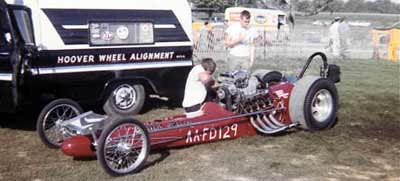|


(Jim Gardner Photo)
Garlits came to The Nationals after having
set the first official NHRA National Record
over 200 mph at Great Meadows, New Jersey.
Another drag racing barrier had been broached.
The West Coast cars came to Indy in force,
each one wanting to knock off Garlits and reclaim
fuel dragster supremacy from the sometimes-hated
Florida “Swamp Rat.”
Garlits was having none of it. He swept the
class run-offs of AA/FD class, a multi-round “race
within a race” that earned him the right
to face the winner of Monday’s eliminations
for overall Top Eliminator. There was
also a great AA/Gas Dragster show, but their
efforts were lost in the clouds of tire smoke
and nitro fumes created by the thundering fuelers.
Garlits brought two cars, but only his Wynns
Jammer was capable of competing.
A team car driven by Connie Swingle was in
the pits, but had crashed the weekend before
in another state. Swingle lost his braking
parachute and the car went off the end of the
track, into a farmer’s alfalfa field.
The result was a destroyed chassis, a fuel
392 that swallowed a considerable quantity
of alfalfa and Swingle on the trailer as a
non-participant. Connie Swingle was Garlits’ primary
chassis builder back in Tampa, and had done
much of the welding and fabricating on the ‘Jammer.
He was also a fine driver and tuner in his
own right. That weekend he helped Garlits prepare
the Wynns Jammer and provided a back-up in
case a spare engine was needed.
In those days even the well-heeled, sponsored “pro” racers
like Garlits raced with the engine that was
bolted into the chassis. Their “spares” consisted
of a few pistons, bearings, rings, spark plugs,
a blower, maybe some different rear axle gears
and other odds and ends. There were few if
any cars sporting spare engines. If a racer
was lucky enough to have a spare motor, it
was usually a short-block, less heads and manifold.
To survive multiple rounds of racing and qualifying
required a deft tuning touch. Sacrificial “banzai” fuel
mixtures and jetting were reserved for late
Monday afternoon for those willing to toss
an engine and maybe a race car into the fire
for Top Speed or Low ET honors. A few of these “time
trials” were run using exotic additives
to the nitromethane-based fuels.
One of the
most popular was hydrazine. When added to nitro,
hydrazine created a volatile, explosive liquid. Several
of these “chemically enhanced” runs
produced spectacular engine explosions and
fires. Fortunately, the only casualties were
the decimated 392 Chrysler Hemi engines that
fell victim to the savage results of “Preparation
H.”
When the final pair was left standing, it
was California’s Jack Williams versus
Garlits for Top Fuel Eliminator. Garlits drove
around Williams and was never bested. The back
of Williams’ car proclaimed: “You
Lose, Pal!” but Garlits had the last
laugh. For his win he took home a modest cash
prize, the Top Eliminator trophy, a Craftsman
Tool Set, a Sturdevant Torque Wrench and assorted
other merchandise awards as Top Eliminator.
The “East vs. West” controversy
was settled, at least for 1964.
Besides the fuelers, there were the “usual
suspects” for a 1960’s Nationals
event. Gassers abounded, and the supercharged
Gassers slugged it out just as the “Gasser
Wars” ads in the drag papers said they
would. The unblown Gassers were aptly represented
with high-revving, gear banging, wheelstanding
runs by each pair, and the tens-of-thousands
of fans got more than their money’s worth
of great drag race action. Comp Eliminator
cars provided unending variety with roadsters,
altereds, Comp Coupes and everything in between,
blown and unblown, displaying a show unlike
any other in drag racing. The Stockers were
making their own names, with colorful names
like “Ramchargers,” “Lawman,” “The
Old Reliable,” “Dyno Don,” and “Color
Me Gone” spicing the competition as factory-backed
cars faced privateers for class and eliminator
honors.
When it was all over on Monday night, I somehow
managed to talk old friend and pioneer Miami
drag racing promoter Ernie Schorb into a ticket
for the Nationals Winners Banquet. At this
annual dinner scores of winners and runner-ups
gathered, rehashing their triumphs or failures
at the ‘64 Nationals and making plans
for next year. It was the first and easily
the most influential of many more successive
years that found me back in Indy for the one
real, true drag race, The Nationals.
|